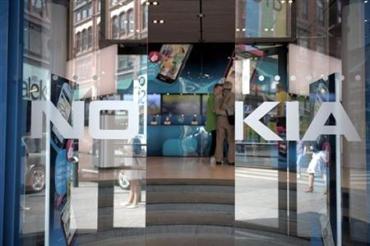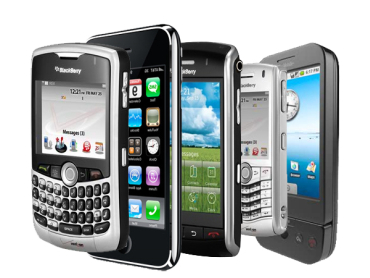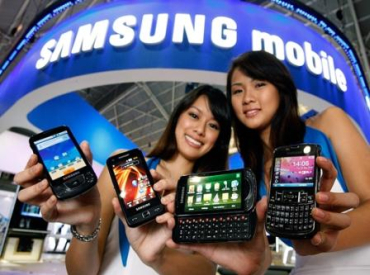 | « Back to article | Print this article |
Battle over smartphones: Samsung takes on Nokia
Samsung is counting on snazzy new products, innovative marketing and vaulting ambition to close the gap on rival Nokia in this lucrative segment.
You might consider him cocky or overly ambitious.
But Ranjit Yadav, Samsung India country head of mobile and IT makes no bones of his company's ambition: "We want to be the number one smart phone player in the country. Our target is to grab 40 per cent market share by the end of this year".
To put this number into perspective, the Korean giant currently has about a 23 per cent share in the eight million per annum smart-phone (phones on which you can download applications) market.
Click on NEXT for more...
Battle over smartphones: Samsung takes on Nokia
But Samsung's confidence to challenge Nokia's numero uno position emanates from the fact that it has tasted blood in the last few weeks, thanks to the runaway success of its new product Samsung Galaxy S2, launched in June this year.
The mobile phone is priced at a steep Rs. 32,890 and was meant to take on the might of Apples' iPhone 4 globally.
But in India, it has already helped the company increase its incremental sales of smart phones by over 20 per cent in the first month.
Click NEXT to read more...
Battle over smartphones: Samsung takes on Nokia
This isn't good news for Nokia which is at a disadvantage because its new range of Windows mobile phones (it has tied up with Microsoft for using their operating system) might take some months to get to the market.
Till then Nokia has to depend on its Symbian operating system which they will slowly withdraw from supporting.
Of course, don't expect Nokia to just sit there and watch Samsung eat away its share of the market.
Click NEXT to read more...
Battle over smartphones: Samsung takes on Nokia
And, just to prove that he means business, Oza says that that Nokia has lined up as many as 10 new smart phones for launch based on the Symbian platform in the next 12 months.
And since the company has also committed that it will continue to support Symbian till 2016, there is no cause for worry to consumers at all.
Click NEXT to read more...
Battle over smartphones: Samsung takes on Nokia
That is because by end of this year the smart phone market is expected to double (over 16 million).
And Samsung has to ship more than three times more smart phones than it did last year if it wants to hit at a 40 per cent share.
Then again, this is a market worth fighting for and not only do Nokia and Samsung known that, they are fully prepared to do what it takes to be the dominant player in it.
Click NEXT to read more...
Battle over smartphones: Samsung takes on Nokia
Just a few days ago RIM took the battle to Samsung's S2 court by introducing the Bold 9900 at Rs. 32,490 virtually the same price as the Koreans major's flagship product.
Even Sony Ericsson and LG are training their guns on the same segment of the market.
After all, prodded by the growth of 3G services and increased data usage industry estimates say that by 2015 as much as 38.5 million smart phones will be shipped to India (which is a fivefold increase from last year), and could constitute over 25- 30 per cent of the total mobile phone market.
Click NEXT to read more...
Battle over smartphones: Samsung takes on Nokia
Samsung is banking on the fact that unlike most of its competitors who are tied down to their own proprietary operating system (Blackberry and Apple) they offer consumers freedom of choice.
"We offer customers Android operating systems, we also offer them Bada which is our own proprietary system and we are also looking at launching some Microsoft Window operating systems. It's a kind of range which our competitors cannot match," says Yadav.
Similarly, Yadav says that Samsung also offers an array of phone forms - so you can get smart phones with QWERTY keys, touch-screens and normal keys.
Click NEXT to read more...
Battle over smartphones: Samsung takes on Nokia
The Korean major is also creating a large base of applications which are useful for its consumers with the mobile phone - which is key - as those buying such high end phones should be able to use it for their varying interest.
So for instance the Samsung Application Store gives consumers looking for Indian relevant applications a huge choice - it offers 150,000 Java and as many as 9,000 Bada and android applications which you can download.
The company has also created a "Samsung Fun Club" from which smart-phone users can download games, video and music.
Click NEXT to read more...
Battle over smartphones: Samsung takes on Nokia
It is not as if Nokia has been blind to the potential in applications. Oza says that the company is creating an eco system around the phones which is key for the success of such products.
For instance Nokia Store offers as much as 17,000 applications which are relevant to India for download just like Samsung's offering.
The Ovi store from which you can also buy music gets over one million hits from India alone.
Also Nokia is bringing down the price barrier - it has introduced a smart-phone which has both the touch as well as the type format for less than Rs. 10,000.
Click NEXT to read more...
Battle over smartphones: Samsung takes on Nokia
For instance, the promotion of its recently launched X-7 was pushed through a gaming competition "Full Throttle".
The competition will be held from 150 outlets in eight cities where gamers can take on each other.
The top 10 winners get to go to the Singapore F1 Grand Prix.
An aggressive marketer, Samsung is well aware that it must also stock its arsenal when it comes to wooing consumers.
Click NEXT to read more...
Battle over smartphones: Samsung takes on Nokia
Says Yadav: "You cannot sell a smart phone from a box. You need to sell if differently."
So, one take-away from their research has been that consumers require using and feeling the smart phone before they fork out a large amount to buy them.
They also need trained staff that can help them in showing the features of these complicated products.
In response to this challenge Samsung has set up 55 Smart Phone Cafes across the country which offer a space where consumers can use the phone and understand its features.
They can also get assistance in downloading applications or understanding features even after they have bought the phone.
Click NEXT to read more...
Battle over smartphones: Samsung takes on Nokia
To ensure that they get the best service Samsung is also training over 1,000 consultants who can handle the S2 and other high end smart phone demonstration.
The Korean consumer electronics major has firmly established itself as the number two player in the mobile market in the country just behind Nokia which despite erosion in its market share still is entrenched at the top slot.
With both companies anxious to reign supreme in this lucrative segment of the handset market, the battle for the top slot has only just begun.












